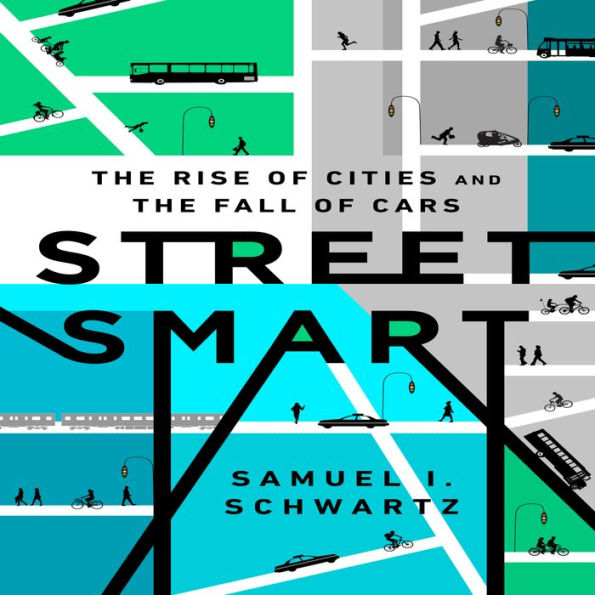“Equal parts transportation-planning compendium, autobiography and love letter to New York City, Street Smart lays out Sam Schwartz's vision for the future of multimodal and multinodal transportation systems…. Touching on everything from the rise of the automobile and the decline and resurrection of streetcars to traffic calming, ride-sharing and the advent of driverless cars, Schwartz combines an engineer's precise logic with broader societal and cultural considerations—and plenty of wry Brooklyn humor—to provide an engaging examination of once and future urban transportation trends.” —Engineering News-Record
“Nobody is more qualified to write a book about transportation than Schwartz.” —City Journal
"A delightful new book." —Michael Sorkin, The Nation
“An engaging trip down memory lane, where trolleys and pedestrians and bicycles intersect and collide with cars in what Schwartz calls ‘an accident of history,' replete with a promising path toward a multi-modal urban revival.” —MoveNY
"Schwartz sees the writing on the asphalt, even if the federal government, intent on building ever more highways, does not. The future isn't on four wheels. If you want your area to attract young people, entrepreneurs, and capital, you have to make it walkable." —Downtown Express
“Street Smart doesn't read as if you were stuck on the Cross-Bronx Expressway ('the most congested corridor in the entire country,' [Scwartz] writes). Rather, it's mostly accessible, discerning and even revealing.” —Sam Roberts, New York Times
“A snappy read…[Schwartz's] account of President Eisenhower's creation of the interstate highway system is riveting, as is his informed discussion of the rise and fall of streetcars.” —Wall Street Journal
“Schwartz…chronicles in Street Smart the history of urban transportation in the U.S. (growing up in Brooklyn, he has lived through a lot of it). … He takes a strong stand, in some cases calling upon personal experiences that streets belong to communities, not cars, and that sustainable transportation planning is helping to revitalize cities.” —Chicago Tribune

Street Smart: The Rise of Cities and the Fall of Cars
Narrated by Don Hagen
Samuel I. SchwartzUnabridged — 9 hours, 12 minutes

Street Smart: The Rise of Cities and the Fall of Cars
Narrated by Don Hagen
Samuel I. SchwartzUnabridged — 9 hours, 12 minutes
Audiobook (Digital)
Free with a B&N Audiobooks Subscription | Cancel Anytime
Already Subscribed?
Sign in to Your BN.com Account
Related collections and offers
FREE
with a B&N Audiobooks Subscription
Overview

Editorial Reviews
08/01/2015
New York Daily News columnist and former New York Department of Transportation chief engineer "Gridlock Sam" debuts with this lighthearted but comprehensive history of Americans' ten-mile average trip to work, shopping, school, and recreation. While Schwartz isn't antiautomobile, he does predict the further decline of the use of private cars, as the linked trends, in the United States and globally, toward walkable cities and shared transportation (trains, carpools, Uber, etc.) continue to increase. Schwartz weaves his experiences in a folksy, effective manner and is unapologetic about his Brooklyn bias. His major themes include "active transportation" (using muscle power), multimodal transportation solutions, accessibility, and the use of intelligent systems to plan traffic routes, while discussing transportation regulations such as the Model Municipal Traffic Ordinance of 1927 in an entertaining way. Historical sections highlight the heroes and villains of U.S. traffic planning as well as key roadways such as the first freeway, the Arroyo Seco Parkway, which connects Los Angeles and Pasadena. VERDICT Anyone interested in how people get from place to place will find this first-person narrative instructive and entertaining.—Sara R. Tompson, Jet Propulsion Laboratory Lib., Archives & Records Section, Pasadena, CA
2015-07-15
How to fix our transportation nightmare? Former New York City traffic commissioner Schwarz ventures some ideas—and while many are oddly counterintuitive, they just might work.One projected infrastructure improvement in which "Gridlock Sam" took part would have rebuilt the Williamsburg Bridge into lower Manhattan, costing $700 million and adding a maintenance bill of $20 million per year precisely in order to add more cars to the traffic mix on the most crowded streets in America. "You could say the costs of the bridge outweighed the benefits, if there had actually been benefits," writes Schwartz, who casts a jaundiced eye on much of the received wisdom, economic and social, around infrastructure improvement. The author instead offers a program that many cities use in part but none in whole. For example, he advocates congestion pricing, a New York innovation applied across the Atlantic in London, to the chagrin of Top Gear but the relief of traffic-trapped drivers. Schwartz's economic lesson is unimpeachable: "when you give something valuable away for free, demand is essentially infinite. As a result, urban traffic congestion just keeps getting worse." Other planks in the platform include multimodal transport systems that facilitate a smooth switch from rail to light rail to bus and the like. Overarchingly, though, a livable city, from a transportation standpoint, is one in which people walk and bike. Schwartz allows that cars are unlikely to disappear anytime soon, but he looks to Internet-smart millennials to create demand for a system in which an individual needs not a car but a smartphone. Traffic circles, streetcars, diagonal crossings: they're all here. And so is Uber, even though Schwartz warns that such an unregulated ride-matching service will mean yet more gridlock: "the numbers won't add up to more mobility, but less." A readable and provocative book making the convincing claim that the best city is one in which people can move around easily.
Product Details
| BN ID: | 2940170405336 |
|---|---|
| Publisher: | Ascent Audio |
| Publication date: | 10/01/2015 |
| Edition description: | Unabridged |
Videos

